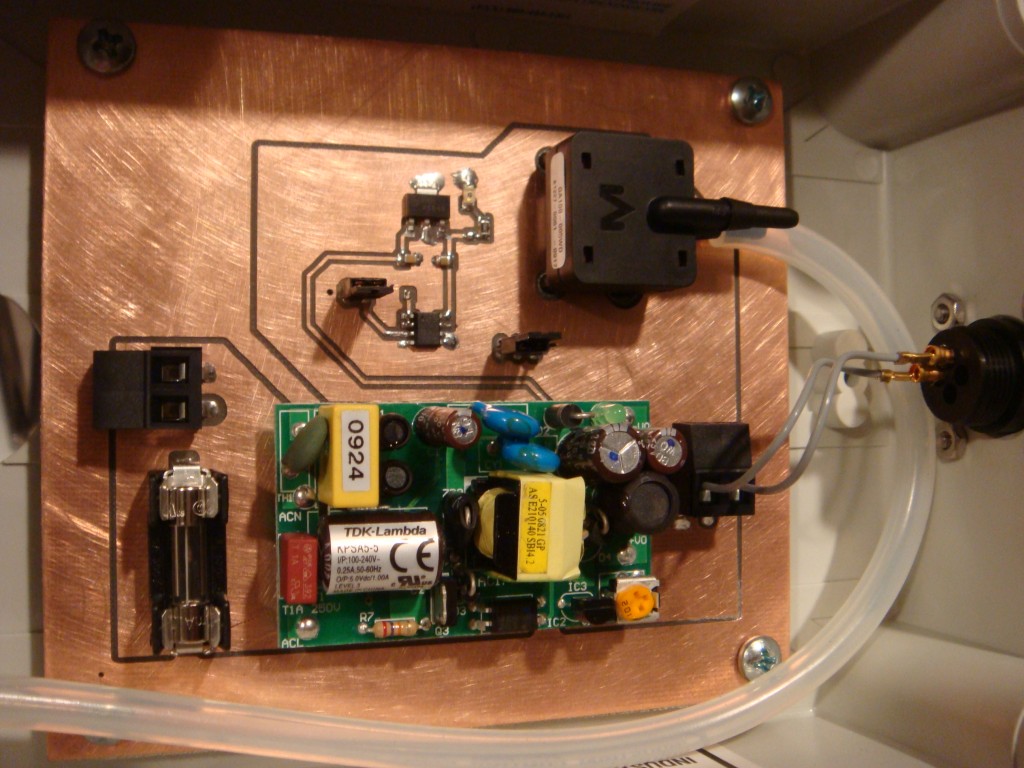Strain-Guage based Pressure Sensor
I just finished building a self-contained pressure sensing device using a MEMS strain-guage type sensor from Measurement Specialties. Single phase AC goes in one side, and a 0.5V-4.5V signal proportional to pressure input comes out the other side. The sensor has a rated max of 5″ of water.

The circuit is simple enough, the AC goes through a fuse and into a AC-DC converter. The output is regulated by a 5V regulator, which powers an op-amp and the sensor. The op-amp buffers the output of the sensor. I used a MAX4242 op-amp, as it can run on less than 5V, and has rail to rail inputs and outputs. This keeps my signal in the CMR range.
I have used products from Measurement Specialties in the past, and they seem to be very good products for the money. I have some of their button load cells which were very affordable and also have about twice the output signal (mV/V) of similar load cells from Omega or Futek.
2 Comments to Strain-Guage based Pressure Sensor
Leave a Reply
Other Stuff
Recent Posts
- 6CY7 dual triode valve amplifier
- Air quality sensor (TVOC and eqCO2)
- Automotive rear fill “surround sound” with Boss DD-3
- Spring tester / weight scale
- Ducati 749/999 Tail Light
- Instruments for the GSXR
- Light pipe tail light for the GSXR
- M17x 6990m / 6970m overheating
- PAR / Spectrum analyzer
- Acrylic polishing and scratch removal
Archives
- May 2019 (2)
- April 2017 (3)
- October 2015 (1)
- May 2015 (1)
- March 2014 (2)
- December 2013 (1)
- July 2013 (1)
- November 2012 (1)
- October 2012 (4)
- September 2012 (1)
- August 2012 (3)
- June 2012 (1)
- March 2012 (1)
- February 2012 (1)
- January 2012 (1)
- October 2011 (3)
- July 2011 (1)
- June 2011 (3)
- May 2011 (2)
- April 2011 (1)
- December 2010 (1)
- August 2010 (1)
- July 2010 (3)
- April 2010 (2)
- March 2010 (2)
- January 2010 (2)
- December 2009 (2)
- October 2009 (2)
- September 2009 (1)
- August 2009 (15)
Would this this work as a scales? I have need for 4-5 scales that will allow a wheelchair to roll on to a platform to weigh kids in our group homes rather than put them in a van and bring them ten miles to the main facility every week or so. Max weight would be about 300 pounds.
I would recommend load cells for a scale application. You could use four load cells, one at each corner of the platform and sum the outputs. I did a prototype a while back of a 4-point force measurement, it’s pretty straightforward. Measurement Specialties has affordable load cells available at digikey or the like that have very good outputs. Use in-amps to amplify the load cell outputs, and then a G.P. op-amp to sum the four values. From there you can feed the data into an ADC. Assuming you used an AVR’s 10bit ADC, and a 400lbs absolute max weight, you would have a best-case resolution of 0.4lbs. Then output the value (with scaling) to an LCD.